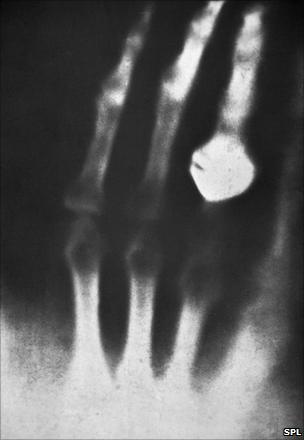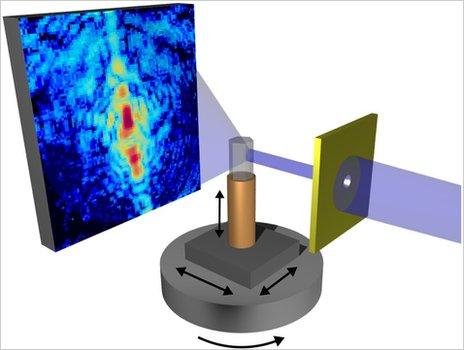Novel X-ray machine is unveiled
- Published
"Nano-CT" pictures of a bone sample with a diameter less than that of a human hair. Clearly visible are interconnective channels between bone cell cavities which are only some 100 nanometres thick
Scientists have demonstrated a refined X-ray technique which can spot tiny variations in bone structures.
The technique uses X-rays delivered by powerful light sources and complex computer algorithms to resolve structural variations as small as 100 nanometres across.
Using the technique, the researchers have mapped in detail a bone fragment narrower than a human hair.
Details of the work are published in the journal Nature.
Synchrotron scale
Hospital X-ray machines work by passing an X-ray pulse through a body onto radiographic film.
The X-rays pass through softer tissue but are mostly absorbed by hard bone - leaving an image in which the skeleton and tissue are clearly distinguishable.

The first X-ray photograph of a human being was taken by Wilhelm Roentgen
In recent years, scientists have been scaling up the power of the X-ray, using massive particle accelerators or synchrotrons to deliver much larger radiation doses.
While these cannot be used on humans for obvious reasons, they can be used in research work to reveal details in materials which are too thick for use in electron microscopes.
But X-ray imaging has its own problems, with X-rays difficult to focus or manipulate even with corrective lenses.
What Martin Dierolf and a team of scientists based in Germany and Switzerland have done is to refine these X-ray techniques.
Instead of relying on how X-rays are absorbed by different materials, they have instead focused on how they are diverted or refracted as they pass through different substances. This "phase contrast" signal gives much clearer and detailed results.
They also abandoned using any corrective lenses, firing the X-ray pulse through a pinhole and then collecting the diffracted rays after they pass through the sample.
They then used a powerful computer programme to rebuild a 3D image of the object scanned by rewinding the passage of the X-rays.
"It's like reconstructing a broken cup by playing the movie backwards and by doing that you bring all the X-rays into the sample to see how they've reacted," says Professor Henry Chapman of the University if Hamburg, who reviewed the study.

The sample is scanned with an X-ray beam and a 3D image is constructed by computer
The prototype was tested at the Swiss Light Source, external synchrotron near Zurich, using a mouse femur fragment narrower than a human hair.
The images obtained show detail down to the cavities in which osteocytes or bone cells reside, and the interconnective channels which are only some 100 nanometers in diameter.
A nanometre is a billionth of a metre.
Pierre Thibault of the Technical University of Munich, who is a member of the research team, says the likely applications are in medical research.
"Our method doesn't scale easily to hospitals and I'm not sure that's what we're aiming at anyway.
"It would be more for pre-clinical studies that are looking for instance at the onset of osteoporosis at the nano scale to see what happens at the scale of the bone cells. That's something we're going to look at in the next few months."
He says there could also be applications in engineering.
"You can look at alloys, how at this scale two different metals combine together because you have such a good sensitivity to different densities you can differentiate the two metals that are in the alloy, or maybe look at fractures inside the materials and see at this scale what's happening."